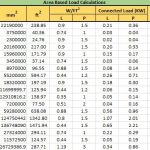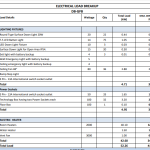Essential Codes and Standards for Electrical Load Calculation
Welcome to our guide on ‘Essential Codes and Standards for Electrical Load Calculation.’ Whether you’re aspiring to become a design engineer or seeking to enhance your expertise, a solid grasp of these codes is indispensable for precise and efficient electrical load calculations. In this article, we’ll explore the essential codes and standards that shape the landscape of electrical load calculations, with a specific focus on lighting loads.
ASHRAE Standard for Lighting Load Guidelines
The ASHRAE (American Society of Heating, Refrigerating, and Air-Conditioning Engineers) Standard 90.1 is widely recognized as a standard for the energy-efficient design of buildings and their systems, including lighting.
One key aspect addressed by ASHRAE 90.1 is Lighting Power Density (LPD). LPD specifies the maximum allowable lighting power for different types of spaces within a building, expressed in watts per square foot (W/ft²) or watts per square meter (W/m²).ASHRAE 90.1 defines specific LPD limits for various space categories, such as offices, retail areas, warehouses, and many more. Designers must ensure that their lighting designs do not exceed these prescribed LPD limits.
90.1 standard offers two primary methods for conducting preliminary load calculations related to lighting. One is the Building Area method, which looks at the building’s overall square footage, and the other is the Space-by-Space method, which considers functional areas individually.
Below are some frequently applied LPD allowances using the area-based approach as per ASHRAE 90.1-2022:

Following are some often-used LPD allowances utilizing the space-by-space method, as outlined in ASHRAE 90.1-2022:

Study more ASHRAE standards and guidelines.
NEC Standard for Electrical Load Calculation
The United States widely recognizes the NFPA 70, also known as the National Electrical Code (NEC), as a comprehensive set of electrical standards and regulations. It serves as a crucial reference for electrical design, installation, and safety in buildings and structures.
Effective Electrical Load Calculations are at the core of designing safe and efficient electrical systems for buildings. The National Electrical Code (NEC) provides indispensable guidelines for determining various load parameters, including general lighting loads, receptacle loads, and demand loads. These values play a pivotal role in appropriately sizing electrical systems, safeguarding against overloads, and promoting energy efficiency. In this article, we present key NEC:2023 code values for these critical load categories, empowering designers and engineers to make informed decisions in their electrical system designs.



Read all NEC codes and standards.
IECC Power and Lighting Rules
The International Energy Conservation Code (IECC) is primarily used in the United States. It belongs to the International Code Council (ICC) family of codes and focuses on conserving energy in building design and construction. Here, we delve into its key provisions, with a particular focus on electrical load calculation, specifically addressing lighting power requirements.
Like ASHRAE, IECC also provides electrical power and lighting requirements using the Building Area Method and Space-by-space Method. The following values represent some commonly used allowances for interior and exterior lighting power.:
Review complete IECC:2021
IET Wiring Standard – BS 7671 Diversity Allowance
BS 7671, commonly known as the IET Wiring Regulations, is the definitive standard for electrical installations in the United Kingdom. It offers essential guidelines and safety requirements to ensure the installation and maintenance of electrical systems to the highest standards, ensuring safety and reliability in both residential and commercial settings. This standard is a crucial reference for electricians, engineers, and anyone involved in electrical work.
According to BS 7671, some commonly used diversity allowances are listed below:

Read the complete BS-7671 standard.
Additional Electrical Load Codes and Standards
There are additional standards and guidelines that may be relevant depending on specific project requirements, locations, and industry sectors. Some other noteworthy codes and standards to consider include:
- IEEE Standards: The Institute of Electrical and Electronics Engineers (IEEE) publishes various standards related to electrical engineering and power systems. IEEE 3000 series standards are particularly important for electrical system design.
- IEC Standards: The International Electrotechnical Commission (IEC) develops international standards for electrical and electronic technologies. IEC 60364 (Electrical Installations of Buildings) is widely used in many countries.
- Local Building Codes: Depending on the region and local jurisdiction, there may be specific building and electrical codes that design engineers must adhere to.
- Energy Codes: Some projects may require compliance with energy codes, such as local energy efficiency regulations.
Conclusion
In conclusion, a web of essential codes and standards intricately binds the world of electrical load calculation. These guidelines, meticulously crafted by experts and institutions, are the pillars of precision, safety, and efficiency in our designs. As design engineers, mastering these codes is not just a requirement but a commitment to excellence. By adhering to these standards, we ensure that our electrical systems are not only functional but also reliable, safe, and environmentally responsible. So, as we wrap up our exploration, remember that these codes aren’t just rules; they are the pathways to engineering brilliance and a brighter, more sustainable future.
Also read: Electrical Load Calculation in Building Design: Step-by-Step Guide

A dedicated Electrical Engineer with expertise in ISO auditing and a strong passion for sharing insights into the electrifying world of design. With over 5 years of diverse experience, I’ve powered through projects ranging from the manufacturing industry to building construction. My skillset extends to automation building design, where my meticulous electrical drawings ensure precision and attention to detail.





